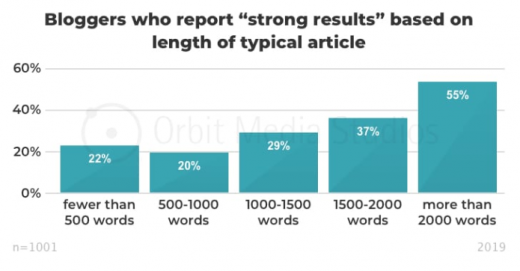How to Create Top-Performing Content on Google According to Science
How to Create Top-Performing Content on Google According to Science

One of the biggest challenges that marketers face is getting their content the attention it deserves. The reason is simple. If nobody reads your content, you stand no chance of succeeding with content marketing. In this post, I want to show you exactly how to create content that will engage your audience and rank high on Google based on data and research.
Why is Search Traffic Important for Marketers?
Search traffic is the real deal and I’ll tell you why in a jiffy. But before then, let me ask you this:
The last time you bought something online, what process did you take before arriving at the product you eventually settled for?
Chances are you did a Google search to learn exactly what your options are, and which is the best one to go for among them.
For most people out there, a Google search is the first thing they do before making any purchase online. This means that if you’re a serious marketer who wants to get great results with your content, you should work hard to rank it on Google.
Research by Rand Fishkin shows that Google refers to about 57.8% of traffic online. This is followed by Facebook and YouTube, with 5.2% and 4.8% referral traffic respectively.
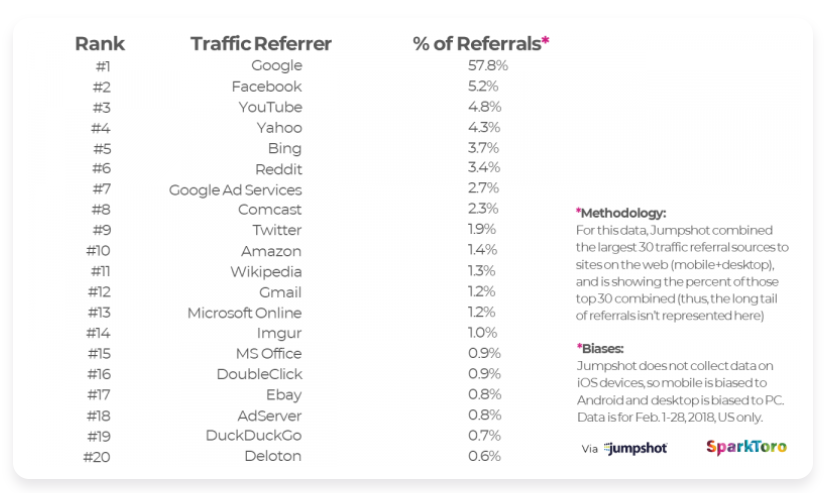
Image Via Sparktoro
Fishkin’s research shows that Google still remains the platform to beat when it comes to making people discover your content online.
Not only does Google traffic outshine other sources, but it also remains steadily on the rise.
According to BuzzSumo’s Content Trends Report, Google sends twice as much traffic to publishers compared to traffic from social media.
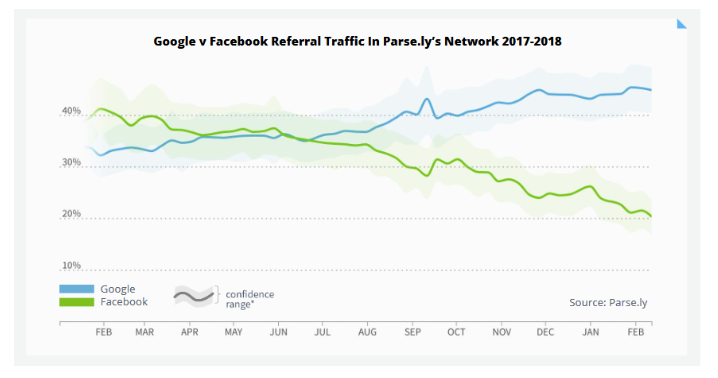
Image via BuzzSumo
From the above chart, you can see that traffic from search engines (especially Google) is the most efficient, reliable, and consistent way to generate traffic to your content.
How to Turn Google to a Traffic Generating Tool for Your Content
Most marketers now turn to Google to generate organic traffic to their content. Due to this, the competition for a top spot in the search engine results pages (SERP) continues to be on the rise.
The SERPs means that you need to do more in order to outshine your competitors and drive those visitors from Google to your website.
Here are the steps you should take to create content that ranks high on Google, according to science.
Step #1: Publish Long-form Content
Gone are the days when you can publish a 500-word article and rank high on the first page of Google. That is not the case nowadays. This is because users are smarter, and appreciate content that goes in-depth to solve the specific problems they face.
Due to this, Google rewards long-form content and ranks them high on the first page. Recent research by SEMrush supports this. The research team found that there’s a correlation between content length and social shares, backlinks, and traffic.
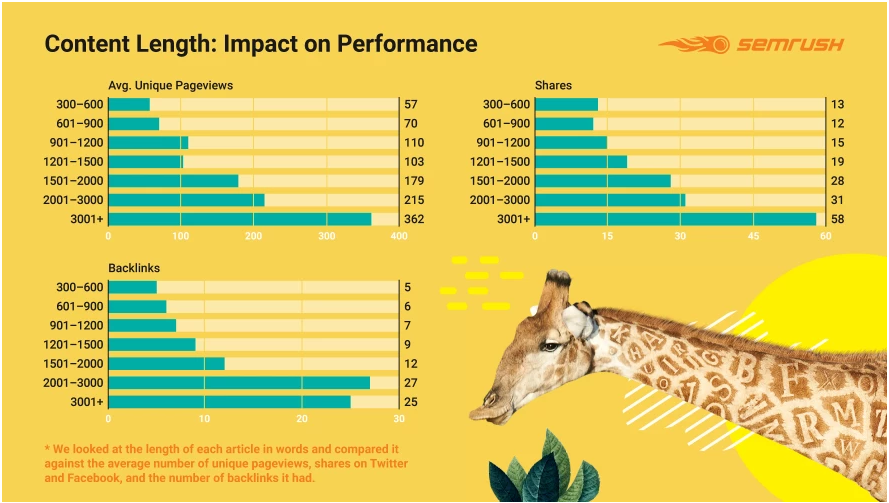
Image via SEMrush
According to the survey of 700,000+ articles, they found that content that has more than 3,000 words performs better than shorter content. In fact, the research shows that long-form content receives three times more traffic, four times more social shares, and three-and-a-half times more backlinks.
In similar research, Backlinko analyzed 912 million blog posts and observed that there’s a correlation between content length and backlinks.
The research revealed that content with at least 3,000 words tends to get an average of 77.2% more backlinks as compared to content which is shorter than 1,000 words. Hence, this type of content typically ranks high on the first page of Google.
Orbit Media also conducted its annual research recently about “How Blogging Has Changed” and also arrived at an interesting conclusion in regards to content length.
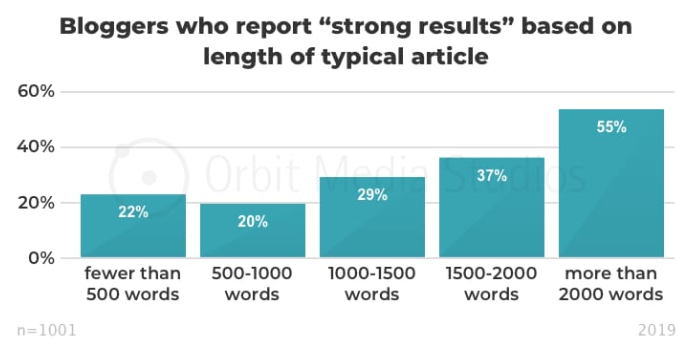
Image via Orbit Media
They found that the average blog post in 2019 is about 1,236 words, which is 53% longer than the average blog post length about six years ago. Not only that, bloggers who publish content with more than 2,000 words report that they get about 55% more results than those who don’t.
From the following, you can see that long-form content is a strategy that must be used by any marketer who wants to rank their content high on Google.
Also, by publishing long-form content, you:
- Become known as an expert and authority in your field.
- Make your content engaging and share-worthy.
- Rank high for your target keywords on SERP.
- Improve your brand awareness.
- Gain more audience for your business.
Step #2: Structure Your Content Appropriately
The structure of your content also determines how it’ll perform on search engines such as Google. This is because the structure of the content affects user experience and the time they eventually spend on your blog.
If your content is well-structured, chances are anyone who stumbles on it takes time to read through. That way, it’ll show Google that it’s a relevant article, and it’ll perform well on the search engine. Otherwise, your content won’t survive the stiff search traffic competition.
Just like every business needs to manage their day-to-day tasks effectively in order to remain relevant, ensuring that you structure your content appropriately is a good practice, you must imbue as a marketer.
SEMrush research cited above shows that there’s a strong correlation between a content’s overall performance and the use of H2, H3, and H4 tags. They found that well-structured content with both H2 and H3 tags are more likely to perform high on Google.
In fact, 36% of content which has H2 and H3 tags do better in terms of traffic, shares, and backlinks.
From the above, you can see that structuring your content appropriately helps in making it perform well on Google.
With a good content structure, you:
- Make it easy for search engines to read and understand what your content is all about.
- Allow users to navigate and digest your content without any hassles.
- Increase your ranking and user-friendliness.
Step #3: Make Sure That Your Title is About 14+ Words Long
Your content headline plays a significant role in making it a top-performing content on Google. In the SEMrush research referenced above, they also found that the headline (H1) of your content impacts the engagement and traffic it gets.
Specifically, they found that articles that have longer headlines (at least 14 words) get two times more traffic, two times more shares, and five times more backlinks compared to those with shorter headlines (about seven to ten words long).
The Backlinko research above also buttresses this fact. The finding shows that there’s a correlation between headline length and social shares. What this means is that the longer your headline, the more likely people will share it on social media platforms.
The research shows that content with a headline of about 14–17 words tends to perform higher (about 76.7%) than those with shorter headlines.
From the above, you can see that your content is more likely to perform better if the headline is considerably long.
With a long headline, you:
- Make people understand exactly what your content is all about. This pushes them to read and most likely share it too.
- Have an opportunity to include the keywords you want to rank for. That way, you have more chances of ranking high for it.
Conclusion
Ranking high for target keywords on Google is a herculean task for many marketers out there. Understandably, the SEO industry is evolving, and the competition continues to be on the increase.
In this post, I’ve shared with you three (3) proven strategies that can make your content perform high on Google. These are science-backed tips you can implement now to get results for your content immediately.
The post How to Create Top-Performing Content on Google According to Science appeared first on ReadWrite.
(32)

